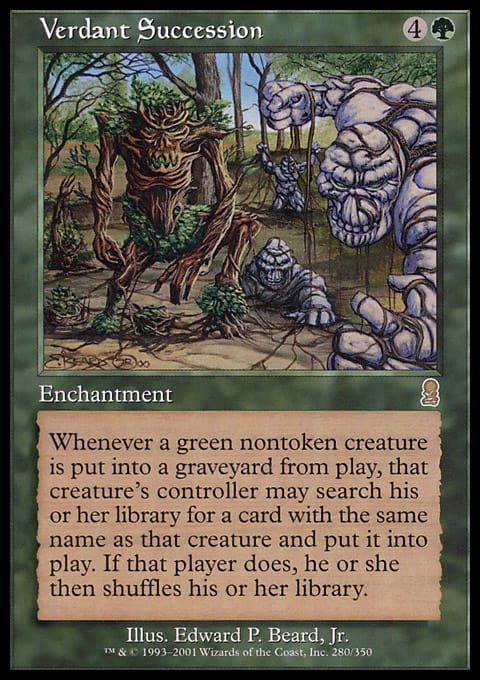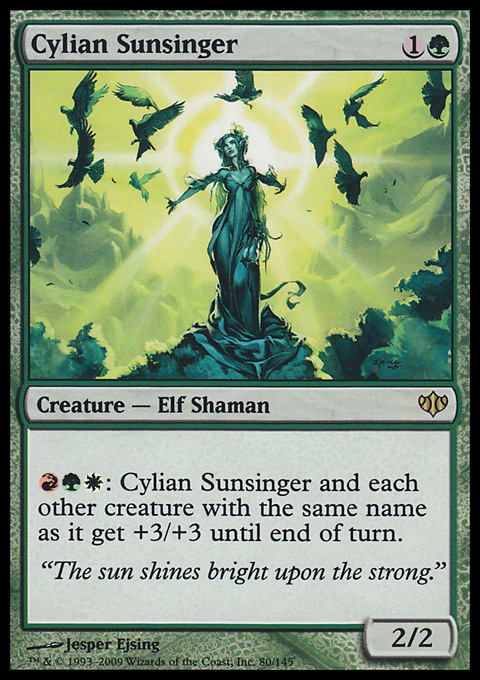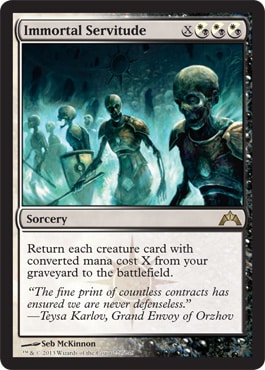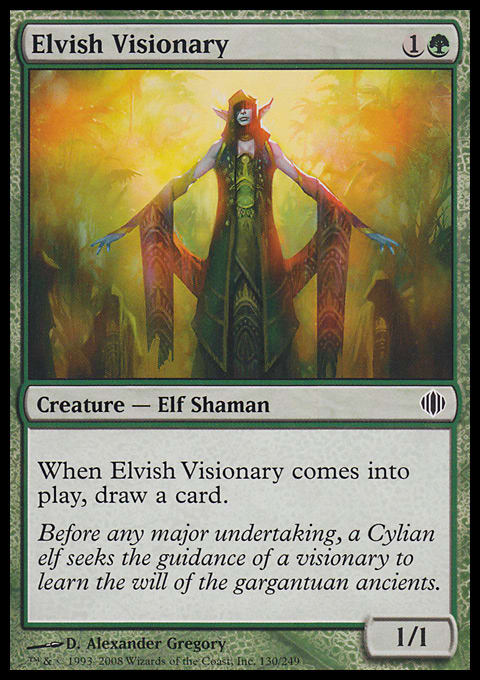In this week’s experiment, we succeed verdantly with a veritable tribe of nature-oriented 2-drops before sacrificing them one by one through Phyrexian means and forcing them into Orzhovian servitude.
Sunsinging
This week, my inspirational card was Cylian Sunsinger. Ever since it was released, it intrigued me. What’s the best-case scenario for this card? How hard should I work to make four of them? How many times can I activate them?
However, this week was the first time I really sat down and brewed something up. The first question was how best to control as many Cylian Sunsingers as possible. One option is to make a bunch of them, such as with Rite of Replication or Progenitor Mimic. Another is to just make all of our creatures copies of the Sunsinger, such as with Mirrorweave or Infinite Reflection.
What I decided to do, however, was to just find a way to put all four copies into play. Still, though, we have options. Pack Hunt just straight-up lets us search for our other three copies once we’ve cast the first. That would be a pretty good plan for a midrange-style Cylian Sunsinger deck. I went with the more combo-oriented option.
Verdant Succession lets us search up replacements for our dying green creatures. Thus, if our Cylian Sunsinger dies, we can find another one. When that dies, we can grab the third, and when the third dies, we fetch the fourth. In a way, that defeats the purpose of building around Cylian Sunsinger. Don’t we want to activate one while three others are play? Isn’t it counterintuitive to activate one with the other three in the graveyard?
As a result, we need a way to return our sacrificed Sunsingers. There are plenty of ways to do this, of course, but I decided to go with Immortal Servitude. For ![]()
![]()
![]()
![]() , we can return all of our dead Sunsingers—and any number of other 2-drops—from our graveyard onto the battlefield.
, we can return all of our dead Sunsingers—and any number of other 2-drops—from our graveyard onto the battlefield.
Green Army
With our combo base of Verdant Succession and Immortal Servitude—oh, and I should have mentioned the Phyrexian Altar—adding more green 2-drops seems to be the next logical step. They need to be green for Verdant Succession’s sake, and they need to be 2-drops so they match up with Cylian Sunsinger and can all come back together from the same Servitude.
Skinshifter – This Druid non-Shapeshifter shapeshifter is among my favorite Magic cards I never have an excuse to play with. It’s too low-impact to play a role in most Commander decks, though I could imagine it being relevant in some Cubes. I love the top-down, animal-shapeshifting druid concept. In this deck, though, it can work to play defense as a 0/8 Plant while still being able to sneak through damage as a Bird or smash through as a Rhino. For ![]()
![]()
![]() , four Cylian Sunsingers can become 4/4 each; for
, four Cylian Sunsingers can become 4/4 each; for ![]()
![]()
![]()
![]() , four Skinshifters can become 4/4 with trample each. That’s a pretty close margin.
, four Skinshifters can become 4/4 with trample each. That’s a pretty close margin.
Brindle Shoat – This card doesn’t have much of a history, as it first appeared in a supplemental product, and while it actually has quite a high power level for something like Limited or even some Block or Standard formats, it just doesn’t cut it for Legacy or Commander. However, when we have Verdant Succession, Brindle Shoat’s death will leave us with both a 3/3 and another Brindle Shoat. That’s a sweet deal.
Wall of Blossoms – This Plant, Stronghold’s original Wall of Omens, is great here, as it lets us set up for our longer game. It replaces itself, and with Verdant Succession, that ability is magnified.
Elvish Visionary – This is like a smaller and far less defensive Wall of Blossoms, but as a green 2-drop that says “draw a card,” it will perform for us quite well.
Magic has plenty of other green 2-drops that could fill these rolls, such as Multani's Acolyte and Wirewood Herald, depending on how you want to build the deck.
The Rest of the Combo
As it stands now, we can play green 2-drops, let them die for value as they’re replaced by Verdant Succession, perhaps using them to generate mana along the way, until we run out of tiny threats in our library or until our Sunsingers and Skinshifters manage to push through enough damage. Copies of Immortal Servitude can give us a second wind or two along the way, and that game plan may run just fine for us and could even be relatively fun—but this really isn’t quite the type of deck I like to build.
There’s one combo element left to cover. Let’s take a look at a possible game sequence including our secret weapon: Battlefield Scrounger.
Turn one: Tapped Jungle Shrine
Turn two: Forest, Wall of Blossoms
Turn three: Phyrexian Altar
Turn four: Elvish Visionary, draw a card, Brindle Shoat
Turn five: Verdant Succession . . . and then things become complicated—
- Sacrifice Elvish Visionary for
 .
. - Search up another Elvish Visionary.
- Draw a card.
- Repeat Steps 1–3 twice.
- Repeat Steps 1–4 with Wall of Blossoms instead of Elvish Visionary, making
 instead of
instead of  .
. - Repeat Step 5 with Brindle Shoat instead of Wall of Blossoms, making 3/3 Beasts instead of drawing cards.
- Cast Cylian Sunsinger.
- Cast Skinshifter.
- Repeat Step 5 with Cylian Sunsinger and then with Skinshifter, but generating no enters-the-battlefield or death triggers.
- Cast Battlefield Scrounger.
- Activate Battlefield Scrounger to put an Elvish Visionary, a Wall of Blossoms, and a Brindle Shoat into the library.
- Sacrifice Battlefield Scrounger for
 .
. - Search up another Battlefield Scrounger.
- Activate Battlefield Scrounger to put a Battlefield Scrounger, a Wall of Blossoms, and a Brindle Shoat into the library.
- Sacrifice Battlefield Scrounger for
 .
. - Search up another Battlefield Scrounger.
From here, as you can see, we can recycle our Battlefield Scroungers while generating mana and recycling other creatures as well. Once the Scroungers have Restocked our other creatures, we can start looping them as well, drawing as many cards as we like with Visionaries and Walls and making as many Beasts as we like with Brindle Shoats. Oh, and we’re also generating as much mana as we want in any combination of colors, so we can put all our Cylian Sunsingers onto the battlefield with Immortal Servitude—once we’re done with all the looping shenanigans and fill our graveyard back up with everything we want to reanimate—and then activate them any number of times, making them essentially as large as we want.
There are two main problems here. One is that we can draw cards that we’d prefer to put onto the battlefield for free, from our library, by using Verdant Succession. In those cases, we might have to play with three or fewer copies in our loops. However, we also hope to be generating enough mana to just cast redundant copies of things—even if our amount of mana is finite, it should still be large.
The second problem is that no matter how large we make our Sunsingers, they won’t be able to attack. I toyed with the idea of not including a haste-granting card, but with the way this deck works, it can be hard to have not-summoning-sick creatures and infinite mana in the same turn. Thus, a haste-granting card really is necessitated. Concordant Crossroads would work, and perhaps a Craterhoof Behemoth could do the job on its own. Madrush Cyclops isn’t bad, but if I’m splashing an additional color anyway, and if I have to play a one-of, I want my haste card to be something sweet for games that don’t go according to the combo plan—or something that can facilitate it. Thus, one copy of Maelstrom Wanderer rounds out the deck.
Sunsinger Succession ? Casual | Andrew Wilson
- Creatures (25)
- 4 Battlefield Scrounger
- 4 Brindle Shoat
- 4 Cylian Sunsinger
- 4 Elvish Visionary
- 4 Skinshifter
- 4 Wall of Blossoms
- 1 Maelstrom Wanderer
- Spells (12)
- 4 Immortal Servitude
- 4 Verdant Succession
- 4 Phyrexian Altar
- Lands (23)
- 9 Forest
- 2 Seaside Citadel
- 4 Jungle Shrine
- 4 Rootbound Crag
- 4 Sunpetal Grove
If you’ve always wanted to make Cylian Sunsinger do something, if you’ve been looking for another weird way to use your Immortal Servitudes, or just if it’s been a while since you busted out Verdant Succession, give this deck a try.
Andrew Wilson
fissionessence at hotmail dot com






























